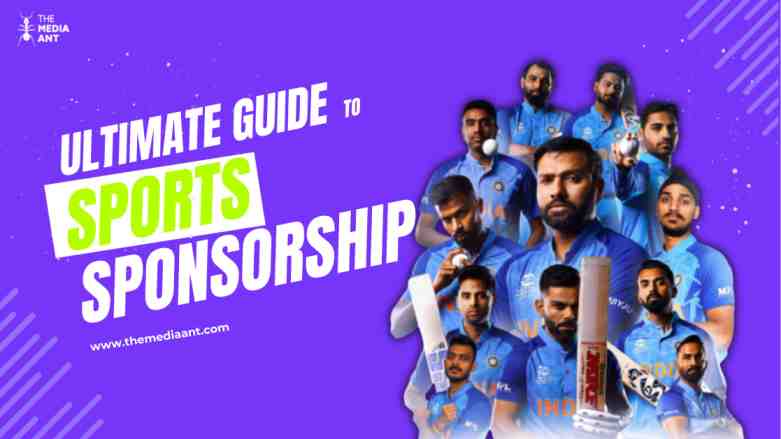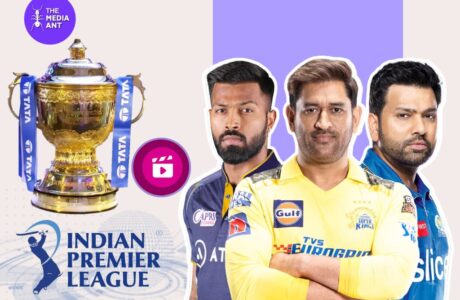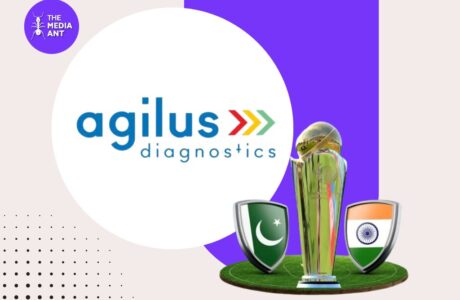Welcome sports enthusiasts, marketing mavens, and curious minds, to the coolest playbook in town! We’re diving headfirst into the electrifying universe of sports sponsorship, and trust us, it’s more than just slapping your logo on a jersey and hoping for the best.
Think of it as the ultimate game-changer, where branding meets sweatbands, and ROI does a victory dance in the end zone. It’s like the secret sauce that makes the sporting world go ’round – turning athletes into legends, stadiums and amphitheaters of dreams, and brands into champions.
Here’s The Media Ant’s handbook to “The Ultimate Guide to Sports Sponsorship,” where we’re about to spill the beans on all things sports and sponsorship. We’ll give you the inside scoop on why it’s the hottest ticket in marketing town, break down the moves of iconic sponsorships, and toss in some creative plays that’ll leave you itching to get in the game.
So, grab your foam fingers, get your game face on, and let’s embark on this epic journey through the world of sports, where rules are made to be bent, and sponsorship is all about scoring big – on and off the field. Stick with us, and you’ll be waving the sponsorship flag like a true MVP in no time!
What is Sports Sponsorship?
Sports sponsorship is a dynamic and multifaceted marketing strategy that involves companies or brands partnering with sports teams, athletes, events, or organizations to achieve various business objectives. In this mutually beneficial relationship, the sponsor provides financial or in-kind support to the sports entity in exchange for a range of promotional opportunities and benefits.
At its core, sports sponsorship is a strategic investment aimed at enhancing a company’s brand recognition, reputation, and profitability. Companies leverage the immense popularity and emotional attachment that people have to sports to connect with their target audience in a meaningful way. By associating their brand with sports, sponsors aim to tap into the passion, loyalty, and enthusiasm that fans have for their favorite teams and athletes.
Sports sponsorship has emerged as a potent marketing tool for brands aiming to boost their visibility, foster customer engagement, and bolster their reputation. This comprehensive guide delves deep into the realm of sports sponsorship, exploring its advantages, best practices, and strategies for success.
Whether you are a brand looking to venture into sports sponsorship or an experienced player in the field, this guide furnishes invaluable insights and industry knowledge to help you maximize your sports sponsorship investment.
What are the various types of sports sponsorship?
Varieties of Sports Sponsorship Sports sponsorship encompasses diverse forms, including:
- Team Sponsorship: Brands can sponsor entire sports teams, encompassing logo placement on team jerseys, signage at team venues, and access to team players for promotional purposes.
- Event Sponsorship: Brands can sponsor specific sports events, such as tournaments or championships, involving naming rights, on-site branding, and exclusive promotional chances.
- Athlete Sponsorship: Brands can sponsor individual athletes, entailing personal endorsements, logo placement on the athlete’s gear, and access to the athlete for promotional purposes.
- Stadium/Venue Sponsorship: Brands can sponsor sports stadiums or venues, involving naming rights, signage, and access to unique marketing assets within the venue.
In 2011, for the first time in India, Sahara India bought the naming rights for the stadium, which is now known as Maharashtra Cricket Association Stadium. As per the then deal, the stadium was called as Subrata Roy Sahara Stadium. However, the deal ended before time, as Sahara failed to pay an amount of ₹98 crores to the MCA for the rights.
Partnering with Pune Supergiants as their’official healthy cooking partners of Rising Pune Supergiants’, Gemini Oil had upped its OOH visibility by branding the stadiums where Pune Supergiants played in 2016. Using hoardings and wall panels, Gemini attempts to tap the large audience that IPL is already catering to.
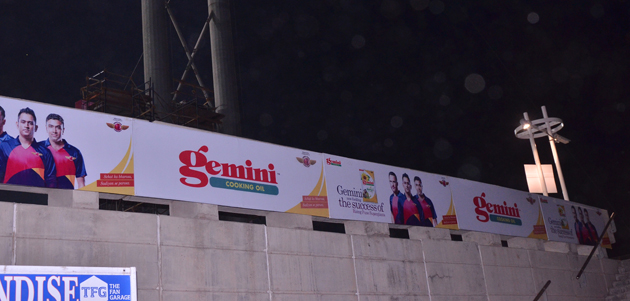
The Significance of Sports Sponsorship for Brands
1. Extending Reach and Engagement
Sports provide an expansive and diverse audience, making them an appealing platform for brands to access their target demographic. Through sports sponsorship, brands can tap into fan passion, create indelible experiences, and cultivate strong emotional bonds with their audience. Additionally, sports events offer a distinctive environment where fans are actively involved and receptive to brand messages.
Sports sponsorship witnessed the highest jump of 105% that is a total of INR 5907 crore, and athlete endorsement value grew to INR 749 Cr that is by 20%. Cricket however, maintained it’s popularity and was the highest contributor to sponsorship of 75%.
2. Enhancing Brand Image and Alignment
Sponsoring a sports team or event enables brands to align effectively with the positive values and qualities associated with sports, such as teamwork, commitment, and a healthy lifestyle. This alignment can elevate the brand’s image, amplify brand recognition, and even reshape the brand’s positioning in consumers’ perceptions.
3. Fostering Market Distinction
In today’s fiercely competitive marketplace, brands must differentiate themselves to stand out among competitors. Sports sponsorship grants brands access to unique marketing assets and opportunities, enabling them to craft persuasive and distinctive marketing campaigns.
Sports sponsorship presents a potent avenue for brands to set themselves apart by aligning with a specific team, event, or athlete.
How is sports sponsorship different from sports marketing & sports advertising?
Sports sponsorship, sports marketing, and sports advertising are related concepts in the world of sports business, but they serve different purposes and involve distinct strategies. Here’s how they differ:
| Sports Sponsorship | Sports Advertising | Sports Marketing |
| Sports sponsorship involves a company or brand providing financial or material support to a sports team, event, athlete, or organization in exchange for various marketing benefits. | Sports marketing encompasses a broader range of activities aimed at promoting sports-related products, services, events, or organizations. | Sports advertising refers to the specific promotional messages and campaigns that use various media channels to reach a target audience. |
| The sponsor typically pays a fee to associate their brand with the sports entity and gain exposure to its audience. | It includes market research, strategic planning, and the execution of marketing campaigns to attract and retain fans, customers, or participants in the sports industry. | It is a subset of sports marketing and is centered around creating and distributing advertising content related to sports. |
| Benefits of sports sponsorship may include logo placement on uniforms, signage at the venue, naming rights for events or facilities, and access to the team or athlete for promotional purposes. | Sports marketing can involve sponsorship, but it also involves other elements such as advertising, public relations, ticket sales, merchandise sales, and fan engagement. | Sports advertising can take many forms, including television commercials, print ads, digital ads, billboards, social media campaigns, and in-stadium or in-arena advertising. |
| The primary goal of sports sponsorship is often to enhance brand visibility and reputation by aligning with the values and fan base of the sports entity. It’s a long-term investment in building brand affinity. | The focus of sports marketing is on creating and implementing strategies to achieve specific business objectives, such as increasing revenue, growing a fan base, or raising awareness. | The primary goal of sports advertising is to create brand awareness, drive product or service sales, and engage with consumers through compelling and relevant content. |
How big is the Indian sports sponsorship market?
- Cricket dominated advertising spends, representing 85% of the total expenditure.
- The primary reason for the surge in cricket endorsements was the increase in the number of matches and the introduction of new teams.
- Sports celebrity endorsements witnessed a significant 20% growth in 2022, reaching ₹749 crore.
- Notably, cricket endorsements amounted to ₹640 crore in 2022, marking an 18% increase. In contrast, endorsements from emerging sports surged by 30% to ₹14 crore.
The report’s standout finding is the unprecedented expansion of sports sponsorship in India, witnessing a remarkable 105% surge from 2021, totaling ₹5,907 crore. This includes ad spends related to on-ground activities, teams, and franchises. With the growing influence of OTT platforms in India, brands are likely to adopt new approaches to invest in sporting events. Clearly, sports advertising offers brands significantly higher returns, given the elevated levels of engagement it delivers.
Shifting focus to a more homegrown sport, one standout in recent years in Indian sports is the Pro Kabaddi League (PKL). Except for a brief setback during the Covid year, PKL has demonstrated remarkable resilience. In 2022, the league hosted two editions, with the first being a result of the delayed start in 2021. The category of “Emerging Sports,” which encompasses all sports except cricket, due to their high growth potential, had a noteworthy year, contributing 15% to the overall sports industry.
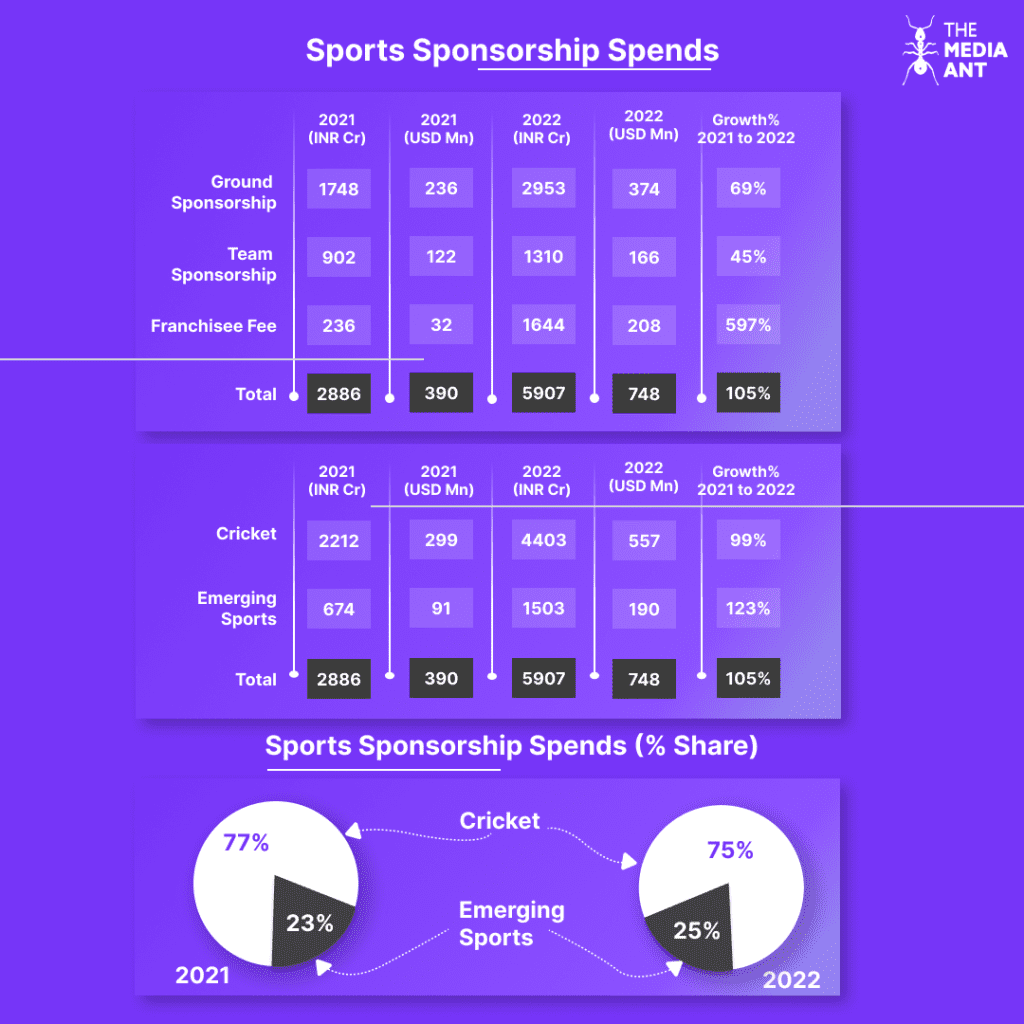
Although the pandemic posed significant challenges for these sports, 2022 witnessed a robust rebound, registering an impressive 87% growth compared to 2021, across the board. Notably, Sponsorship took a larger slice of the pie at 25%, in contrast to Media Spends (6%) and Endorsements (15%).
This shift could be attributed, among other factors, to certain brands showing a propensity to establish mutually beneficial relationships with up-and-coming properties, even when they are relatively smaller in scale at that point.
What are the factors contributing to the growth of sports sponsorship in India?
According to Sporting Nation 2023, India’s sports sponsorship industry is expanding at an unheard-of rate, with spending on teams, franchises, and venues increasing by a combined INR 3021 crore, or 105%, from 2021 to 2023. The ICC T20 World Cup, Asia Cup, FIFA World Cup, and the return of emerging sports events and tournaments like the PKL, marquee marathons, Maharashtra Open, and Commonwealth Games 2022 are all cited in the report as contributing factors to the overall increase in spending.
The report also emphasizes the phenomenal growth of Indian women athletes and women cricketers. With the Indian women’s cricket team establishing itself on the world stage. It also reveals that, with a 14% CAGR, the sports sector is one of the better-performing economic sectors. The report highlights important aspects of how brands are anticipated to approach spending on sporting events differently as OTT usage increases. In addition, India will host the inaugural editions of the two major international racing competitions. Formula E & Moto GP, in 2023.
Here are some major reasons for the increase in sports sponsorship:
- Growing Sports Culture: There has been a significant rise in the popularity of sports in India. Cricket, in particular, has a massive following, but other sports like football, kabaddi, and badminton are also gaining traction. As more Indians engage with sports, sponsors see opportunities to connect with a broader audience.
- Rise of Non-Cricket Sports: While cricket remains the dominant sport, the emergence of professional leagues like the Indian Premier League (IPL) for cricket and Indian Super League (ISL) for football has generated interest in other sports. This diversification creates opportunities for sponsors to tap into new fan bases.
- Increase in matches & tournaments: In highly popular competitions, especially in cricket, we saw the growths by way of the event itself expanding in terms of number of teams and matches, as well as through the rate revisions that happen as a consequence of the increasing levels of viewership and public attention, leading to exponential effect in industry growth figures! This is indicative of the fact that even in sports which are ahead in the commercialization curve in India, the growth potential continues to be immense.
- Television and Digital Broadcasting: The proliferation of sports broadcasting on television and digital platforms has allowed sponsors to reach a wider and more engaged audience. Live streaming, highlight packages, and exclusive content have expanded the reach of sports events, making them attractive for sponsors looking to advertise. JioCinema revolutionized the OTT viewership with the free live streaming of IPL 2023, and broke all records by gaining 13 Bn video views.
How does sports sponsorship help in brand building?
Sports sponsorship is a powerful marketing strategy that can significantly contribute to brand building for Indian companies. It offers a unique opportunity to enhance brand visibility, engage with a wide and diverse audience, and create lasting emotional connections. To understand how sports sponsorship aids in brand building, let’s explore three key aspects: reach, frequency, and impact, with examples of Indian brands.
Reach:
One of the primary advantages of sports sponsorship is its ability to provide brands with an extensive reach, both domestically and globally. Sporting events and athletes attract massive audiences, making them ideal platforms for Indian brands to expand their visibility.
Example: The Indian Premier League (IPL), a professional Twenty20 cricket league in India, is a prime example of a platform with remarkable reach. Brands like Vivo, Pepsi, and Paytm have sponsored IPL teams, gaining access to millions of cricket enthusiasts across the country. This exposure is invaluable for these brands as they reach not only the urban population but also tap into the massive cricket-following audience in rural India.
Furthermore, the IPL garners international attention, allowing Indian brands to extend their reach beyond borders. This global exposure can be especially advantageous for companies seeking to establish a global presence or export their products and services.
Frequency:
Consistency and repetition are fundamental elements of successful brand building. Sports sponsorship offers brands the opportunity to maintain a high level of visibility and engagement over an extended period, which is crucial for creating brand recognition and recall.
Example: Tata Motors’ sponsorship of the Indian Super League (ISL), a professional football league in India, demonstrates the significance of frequency in brand building. Tata Motors’ logo is prominently displayed on the jerseys of Jamshedpur FC, a team in the ISL. Throughout the ISL season, which spans several months, Tata Motors’ branding is showcased during every match. This prolonged exposure ensures that the brand remains top-of-mind for football enthusiasts, contributing to brand familiarity and loyalty.
Additionally, Indian brands often leverage their sports sponsorships by running concurrent marketing campaigns. These campaigns capitalize on the sports fervor and complement the frequency of brand exposure. They can include TV commercials, social media initiatives, and interactive fan engagement activities.
Impact:
The impact of sports sponsorship extends beyond mere visibility; it influences consumers’ emotions, perceptions, and attitudes toward a brand. Associating with sports entities allows Indian brands to leverage the passion, excitement, and loyalty that sports evoke among fans.
Example: Amul’s long-standing association with cricket in India demonstrates the impact of emotional connection. Amul, known for its witty and topical advertisements, frequently creates cricket-themed ads during major cricket tournaments like the ICC Cricket World Cup and the IPL. These ads capture the spirit of the game and resonate with cricket fans on a personal level. As a result, Amul is not just seen as a dairy brand but also as an integral part of cricketing culture in India. This emotional connection fosters brand loyalty and a sense of nostalgia among consumers.
Moreover, sports sponsorship enables brands to align themselves with the values and qualities associated with sportsmanship, teamwork, perseverance, and excellence. These associations can significantly enhance the brand’s image and credibility.
Who should consider sports sponsorship?
Sports sponsorship has definitely become the gold standard of brand visibility and engagement, making it a coveted item on nearly every marketer’s wishlist. However, it’s crucial to recognize that while sports sponsorship can benefit various brands, it’s particularly well-suited to certain types of businesses.
As we discussed, every brand that aims to evoke emotions and forge strong emotional connections with their audience benefit greatly from sports sponsorship. The passion and loyalty exhibited by sports fans provide a fertile ground for creating lasting brand loyalty.
But brands from certain industries might be better placed than others to capitalize on the platform of sports sponsorships, according to a new YouGov study conducted across 17 markets worldwide.
Brand sectors that can benefit from Sports Sponsorship:
Sports sponsorship can be beneficial for a wide range of brand sectors, as it offers various opportunities to connect with audiences, reinforce brand values, and enhance visibility. Here are some brand sectors that can benefit from sports sponsorship:
Sporting Goods and Apparel Brands: Companies that manufacture or sell sporting goods, athletic apparel, and equipment can directly align their products with sports events and teams. Sponsorship allows them to showcase their products and connect with sports enthusiasts.
Beverage Brands: Beverage companies, particularly those producing energy drinks, sports drinks, and alcoholic beverages, often sponsor sports events, teams, or athletes to promote their products to a sports-focused demographic.
Automobile Manufacturers: Automobile brands often sponsor sports events, teams, or athletes as a way to highlight their vehicles’ performance, reliability, and innovation. Motorsports, in particular, offer a natural fit for automotive sponsorship.
Financial Services: Banks, insurance companies, and investment firms can benefit from sports sponsorship to enhance their brand image, build trust, and connect with potential customers who may be interested in financial planning or investment opportunities.
Technology and Electronics: Tech companies can use sports sponsorship to showcase their products, especially if they are related to sports technology, such as wearables, streaming platforms, or gaming devices.
How Brands are Supporting Emerging Sports?
Amul’s Association with FIFA 2023 as Regional Sponsors
It’s not a common sight to witness Indian brands making a significant impact on the global sports stage. However, this iconic dairy brand, known for its enduring presence, is no stranger to innovative advertising tactics. The unforgettable Amul Girl, the brand’s iconic mascot, pioneered the concept of moment marketing in India, leaving an indelible mark.
In the realm of sports, apart from football, Amul has made unique sponsorship choices in cricket, setting itself apart by supporting teams like Ireland and Afghanistan.
Jayen Mehta has been associated with Amul for over three decades, serving in various roles, including brand manager, product manager, general manager (marketing), and currently as the Chief Operating Officer.
As the FIFA World Cup approaches, we had an exclusive conversation with Mehta to delve into Amul’s plans for activating its brand during the upcoming football World Cup, its iconic brand-building strategies, sports sponsorship approach, and the rationale behind its frequent support for underdog cricket teams.
TATA Motor’s Association with Jamshedpur FC
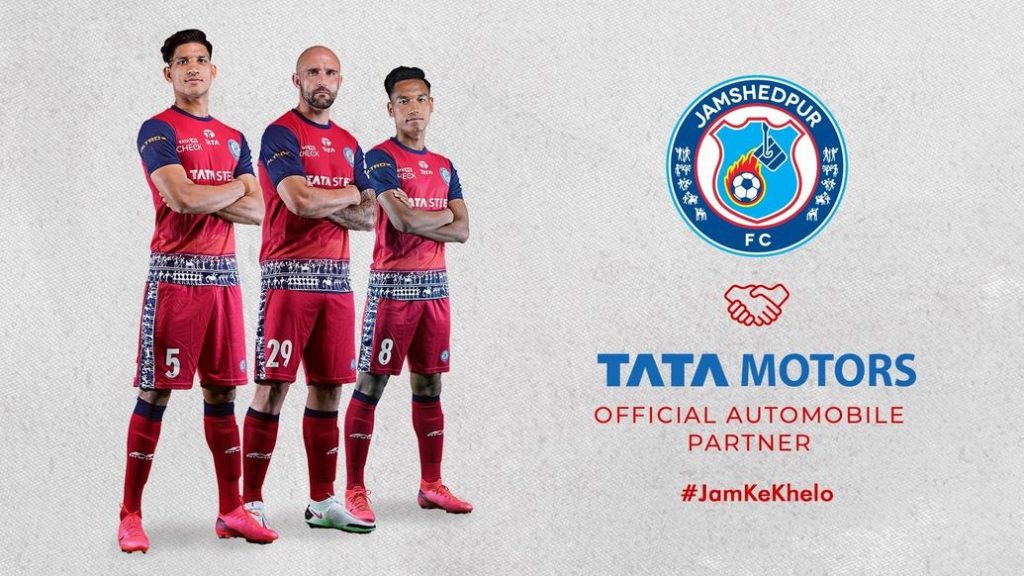
During the 2021 ISL tournament, Jamshedpur FC secured Tata 1mg as their official health partner. As part of this agreement, the brand’s logo was featured on the players’ shorts, and it was also promoted within the stadium during the club’s home games.
Jamshedpur FC also extended their partnerships with Tata Motors and NIVIA. Tata Motors continued as the club’s automobile partner and used the opportunity to showcase their first sub-compact SUV, PUNCH. Additionally, NIVIA and Jamshedpur FC inked a two-year extension deal, with NIVIA becoming the official kit partner for the club.
Tata Motors boasts a strong history of affiliations with various sports ventures. This multinational conglomerate has actively participated in some of India’s most significant and prominent sporting events, including the recently concluded Indian Premier League. Tata Motors’ close partnership with Jamshedpur FC dates back to the club’s inaugural Hero ISL season in 2017-18, marking the third consecutive year of this remarkable collaboration aimed at promoting Indian Football.
The Jamshedpur FC match attire prominently featured the Tata Tiago logo on the sleeves and shorts. Furthermore, the brand-new Tata Tiago model was showcased at the JRD Tata Sports Complex during Jamshedpur FC’s home matches. As part of this association, the club also had plans to engage with their fan base through a series of captivating campaigns and contests across Jamshedpur FC’s digital media platforms.
Odisha Sponsoring India Hockey
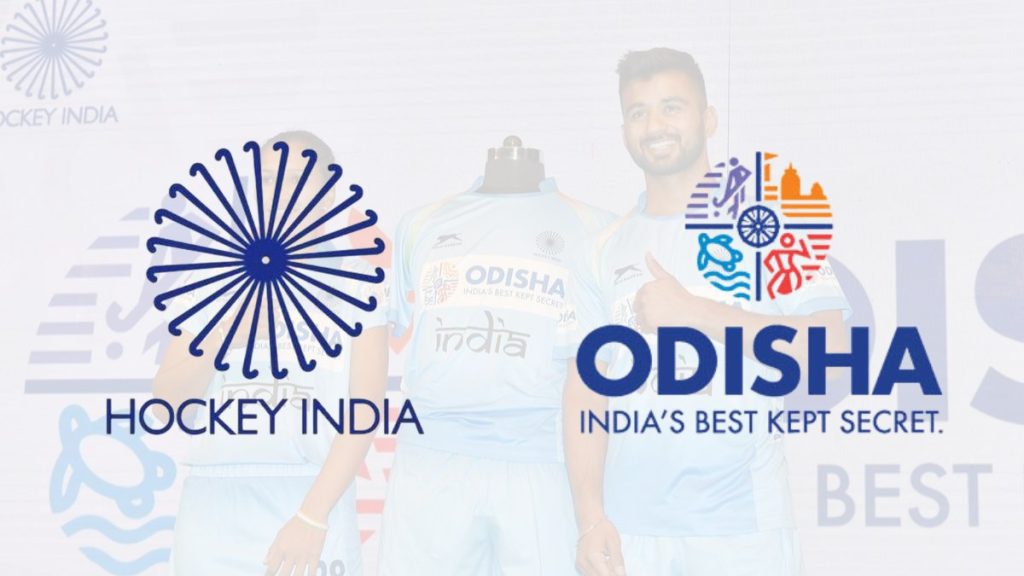
The Odisha government has struck an unprecedented agreement to sponsor India’s men’s and women’s hockey teams for the next five years. This marks a groundbreaking move where a state government, in addition to promoting a sport within its borders, will also be actively nurturing and supporting Indian hockey.
Esteemed hockey figures, both past and present, including Dilip Tirkey, Viren Rasquinha, and Dhanraj Pillay, have given their endorsement to Odisha, affirming its status as a beloved destination among hockey players.
Following Sahara’s departure in 2018, the Odisha government assumed the mantle of sponsorship for Indian hockey teams across junior and senior levels. In a groundbreaking move, the state inked a Rs 150 crore agreement with Hockey India to support both men’s and women’s hockey teams for the next five years. Notably, this marked the inaugural instance of a state government sponsoring a national team.
In a collaborative effort with the Tata group in 2018, Odisha established the Odisha Naval Tata Hockey High-Performance Centre (HPC) at Bhubaneswar’s Kalinga Stadium.
Factors that determine brands to go for Sports Sponsorship or Sports Advertising
Sports advertising and sports sponsorship are two different strategies that brands can use to connect with their target audience. The choice between the two depends on the brand’s goals, budget, and target audience. Let’s explore the pros and cons of each in the context of sports marketing:
When should a brand do Sports Advertising:
Advantages of Sports Ads
Reach:
- Massive Viewership: Major sports events like the Indian Premier League (IPL) or the FIFA World Cup have a massive global viewership. These events attract millions, if not billions, of viewers from diverse demographics and regions.
- Diverse Audience: Sports events draw in a broad and diverse audience. People from various backgrounds, ages, and interests come together to watch these events. This diversity provides brands with the opportunity to reach a wide range of potential consumers.
- Targeted Segmentation: Brands can leverage the popularity of sports events to target specific segments of the audience that align with their products or services. For example, a fitness brand might target viewers interested in sports and physical activity.
Frequency:
- Repeated Exposure: During a single sports event, there are multiple commercial breaks where brands can air their advertisements. This means that viewers are exposed to the brand’s message multiple times throughout the event.
- Increased Recall: Repetition can lead to increased recall and recognition. When viewers see a brand’s message multiple times in a short period, it becomes more likely that they will remember the brand and its offerings.
- Message Reinforcement: Frequent exposure to advertisements during a sports event allows brands to reinforce their key messages or slogans, making them more likely to stick in the minds of consumers.
Message Linkage:
- Strong Associations: Associating a brand with a specific sport, team, or athlete can create a strong and memorable connection in the minds of consumers. This connection goes beyond the product or service and taps into emotions and values associated with the sport.
- Emotional Appeal: Sports often evoke strong emotions in fans. By linking their brand to a beloved sport or athlete, brands can tap into these emotions and build a deeper emotional connection with their audience.
- Endorsement Effect: When a popular athlete endorses a brand or product, consumers may transfer their admiration and trust for the athlete to the brand. This endorsement effect can enhance the brand’s credibility and influence purchase decisions.
Disadvantages of Sports Advertising:
- Engagement: While sports advertising can reach a large audience, not all viewers may be actively engaged with the advertisements. Some may tune out or use commercial breaks for other activities.
- Ad Clutter: Sports events often have numerous advertisers vying for attention during commercial breaks, leading to ad clutter. This can make it challenging for a brand’s message to stand out.
- Intrusiveness: Some viewers may find commercials during sports events intrusive and may resent interruptions to their viewing experience.
When should a brand do Sports Sponsorship:
Advantages of sports sponsorship:
Subliminal Impact:
- Integration into the Fabric: Sports sponsorship allows a brand to seamlessly integrate itself into the sports event or team’s activities and culture. This integration creates a subliminal association between the brand and the sport or team, as it becomes an integral part of the fan experience.
- Long-Term Brand Loyalty: Over time, this subliminal association can lead to long-term brand loyalty. When consumers consistently see a brand associated with something they are passionate about, such as their favorite sports team, it can foster a deep sense of loyalty and affinity towards that brand. This loyalty can extend for years, even decades.
Impact on Brand Perception:
- Enhanced Brand Credibility: Sponsoring a respected sports team or event can significantly enhance a brand’s credibility and prestige. Fans often hold their favorite sports entities in high regard, and when a brand aligns itself with these entities, it can inherit some of that positive perception.
- Positive Brand Attributes: The attributes associated with the sports team or event, such as teamwork, excellence, and dedication, can transfer to the brand. Consumers may perceive the brand as embodying these qualities, which can improve its image and reputation.
No Clutter:
- Uncluttered Brand Exposure: Unlike sports advertising, which competes with numerous other advertisers during commercial breaks, sponsorship offers a clutter-free environment. The brand’s presence is not diluted or overshadowed by other competing messages.
- Focused Attention: Sponsors often receive focused attention from fans and attendees. When the brand is integrated into the event or team’s activities, it enjoys a dedicated spotlight without distractions, ensuring that the message is clear and unobstructed.
- Less Viewer Resistance: Sponsorship is generally perceived as less intrusive compared to traditional advertising. Viewers and fans are often more receptive to brand messaging when it is seamlessly integrated into their sports experience, as it feels more organic and less disruptive.
Disadvantages of sports sponsorship:
- High Cost: Sports sponsorships, especially for major events or teams, can be extremely expensive. Smaller brands with limited budgets may find it challenging to afford such partnerships.
- Lack of Content: Sponsoring a sports event or team may not provide as much control over content as advertising. Brands may have limited opportunities to convey their specific messages.
A well-rounded sports marketing strategy might involve a combination of both advertising and sponsorship to maximize reach, engagement, and impact while managing budget constraints and content preferences.
CRED IPL 2020 Case Study
In the 2020 edition of the IPL, CRED initiated its first-time partnership with the league. The platform joined as an official league sponsor in collaboration with the BCCI and also became the official broadcast associate sponsor. This move aimed to not only enhance on-ground activations and branding but also capitalize on advertising breaks during telecasts through a well-thought-out TVC campaign.
Observation and Strategy:
For fintech brands, visibility alone is insufficient; they must also establish trustworthiness for customers to rely on their services. This is particularly crucial for CRED, a relatively new player in an industry dominated by traditional giants with a strong marketing presence.
It’s notable how CRED, being a newcomer, strategically leveraged this opportunity.
They targeted their advertising towards a specific audience—the first-generation wealthy, who are more likely to use credit cards. CRED achieved this by providing its campaign exclusively during IPL matches’ HD broadcasts. This careful segmentation effectively filtered out an unrelated audience segment, making it a smart customer acquisition move.
Case Study on CRED’s IPL 2020 Success:
A global event like the IPL, due to its extensive broadcast reach, not only garners a vast television viewership for partner brands but also fosters recall through targeted campaigns and initiatives. This continuous recall piques curiosity, which the brand can then utilize for customer acquisition. In the case of CRED, the IPL served as a platform that garnered the desired attention through its targeted approach.
In Conclusion
Sports sponsorship in India is not just a financial transaction; it’s a powerful bridge that connects brands with a passionate and diverse audience. As we’ve explored in this blog, it has grown from a marketing strategy into a vital element of India’s sports ecosystem. From cricket to kabaddi, brands have harnessed the nation’s love for sports to create meaningful and lasting connections.
The digital age has further amplified the impact of sports sponsorship, offering brands unprecedented opportunities for engagement and interaction with fans. While challenges exist, including navigating the complexities of various sports organizations, the potential rewards are significant.

